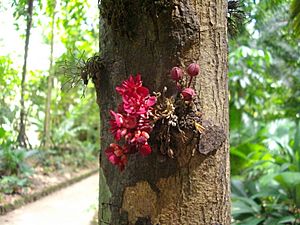Theobroma speciosum facts for kids
Quick facts for kids Theobroma speciosum |
|
|---|---|
 |
|
| Flowers of T. speciosum in bud and in bloom | |
| Scientific classification | |
| Genus: |
Theobroma
|
| Species: |
speciosum
|
| Synonyms | |
|
|
Theobroma speciosum is an arboriform species of flowering plant in the mallow family native to northern South America. It is the 35th most abundant species of tree in the Amazon rainforest.
Contents
Name
Specific epithet
The specific epithet 'speciosum' is used to indicate that a plant is aesthetically pleasing; it is a neuter form of 'speciosus', which is Latin for 'beautiful'.
Common names
Theobroma speciosum has a number of common names:
- In Bolivia it is called chocolatillo
- In Brazil it is called cacauí or cacau de macaco
- In Peru it is called cacaoy, cacaoíllo, cacau-rana, cacao biaro, cupuyh or cacao sacha
Description
Theobroma speciosum is an evergreen tree that grows up to 15 m (49 ft) tall. The trunk is straight, with plagiotropic (horizontally growing) side branches. The canopy is small. Its leaves are simple, and have a coriaceous (leather-like) surface with trichomes (hairs). Leaf arrangement is distichous (leaves alternate between one side of the stem and the other). Flowers are red, and grow on the trunk in dense clusters. Fruits are 10 cm (3.9 in) in length, and comprise approximately 20 seeds surrounded by a white flesh, which in turn is surrounded by a capsule.
Distribution
Theobroma speciosum is native to:
- Bolivia
- Brazil, where it has been recorded as present in the following states:
- Peru
- Venezuela
Ecology
The fruit of T. speciosum is a food source for primates and rodents. Its flowers are pollinated by flying insects.
Uses
Food
The flesh of the fruit of is eaten by the Ka'apor and Tacana peoples. The seeds are used to make chocolate, and could also be used to make cocoa butter substitutes.
The flowers are edible, and contain high concentrations of antioxidants.
Hygiene
The fruit capsules can be used to make soap and deodorant.
Genetic resource
As a crop wild relative, T. speciosum could be used as a source of genetic variability for T. cacao, which is widely cultivated for its cocoa beans.
Ornamental
T. speciosum is occasionally grown in gardens as an ornamental plant.
Diseases
Colletotrichum luxificum, a species of pathogenic fungus, can cause witch's broom disease in Theobroma speciosum.


